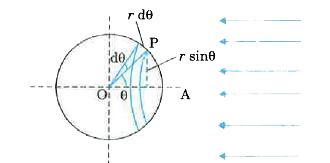There is a parallel beam of light of larger aperture . Let I be the intensity of light . Perfectly reflecting sphere of radius r is kept in the path of this parallel beam . Find the force exerted by the light beam on sphere .
Let us select a reference line OA opposite to the direction of incident beam. Here O is centre of the sphere .

Let us select a radius OP of sphere at an angle θ with the reference line OA . Rotate this radius OP around OA to get a circle on sphere . Now increase this angle to θ+dtetha and again rotate OP about OA to get one more circle. Radius of this circular ring segment is rsintetha .
Total are of this ring segment will be 2π(rsinθ)(rdθ)=2πr2sinθdθ.
It we select some are ΔA , then corresponding linear momentum falling on the same surface will be ΔU/c . Light will be reflected at the smae angle with the normal and hence change in linear momentum can be written as follows :
Δp/Δt=(2/c)IΔAcos2θ
The above expression is basically for the force acting on ΔA portion of ring segment . This force acts perpendicular to the surface of the ring. And from symmetry , we can understand that components perpendicular to OA will be canalled and these along OA will be added, hence contribution of this force to the total force will be just component perpendicular to beam and can be written as follows :
(Δp/Δt)cosθ=(2/c)IΔAcos3θ
Now we can replace ΔA with the total area of ring segment to get the force exerted on selected ring segment.
dF=(2/c)I(2πr2sinθdθ)cos3θ
We can calculate total force on sphere by integrating the above relation for θ=0∘ to90∘ because light is falling on the front portion of the sphere.
F=4πr2Ic∫π/20cos2θ(sinθdθ)
F=4πr2Ic∫π/20cos2θ(sinθdθ) ...(i)
Let t=cosθ⇒dt=−sinθdθ
Substituting above values in equation (i) , we get the following :
F=4πr2Ic[t34]01
⇒F=πr2Ic
Topper's Solved these Questions
- DUAL NATURE OF RADIATION AND MATTER BOOK - MODERN PUBLICATIONCHAPTER - DUAL NATURE OF RADIATION AND MATTER EXERCISE - Revision Exercises (Very Short Answer Questions)
45 Videos
- DUAL NATURE OF RADIATION AND MATTER BOOK - MODERN PUBLICATIONCHAPTER - DUAL NATURE OF RADIATION AND MATTER EXERCISE - Revision Exercises (Additional Questions)
8 Videos
- DUAL NATURE OF RADIATION AND MATTER BOOK - MODERN PUBLICATIONCHAPTER - DUAL NATURE OF RADIATION AND MATTER EXERCISE - NCERT FILE (NCERT - Exemplar Problems - Subjective Questions (Short Answer Type Questions))
6 Videos
- CURRENT ELECTRICITYBOOK - MODERN PUBLICATIONCHAPTER - CURRENT ELECTRICITYEXERCISE - Chapter Practice Test
15 Videos
- ELECTRIC CHARGES AND FIELDS BOOK - MODERN PUBLICATIONCHAPTER - ELECTRIC CHARGES AND FIELDS EXERCISE - Chapter Practice Test
15 Videos
Similar Questions
A sphere of radius 1.00 cm is placed in the path of a parallel beam of light of large aperture. The intensity of the light is 0.50 W cm−2. If the sphere completely absorbs the radiation falling on it, find the force exerted by the light beam on the sphere.
View SolutionForce Exerted By A Light Beam On A Surface
View Solution
Knowledge Check
A perfectly reflecting solid hemisphere of radius R is placed in the path of a parallel beam of light of large aperture. If the beam carrries an intensity l, find the force exerted by the beam on the hemisphere.
A2πR2lcBπR2lcC4πR2lcDNone of theseA parallel beam of light falling on the eye gets focused on the retina because of refractions at
Athe corneaBthe crystalline lensCthe vitreous humorDvarious surfaces in the eyeA parallel beam of light falls on a solid tranparent sphere.

Q. Which is corret?AIf the beam is thick, then whole beam can be focussed at A.Bthe whole beam can be focussed at A only if the beam is thin enoughCif the beam is thin, then the beam can't be focussed before A.Dnone of these
A perfectly reflecting solid sphere of radius r is kept in the path of a parallel beam of light of large aperture. If the beam carries an intensity I, find the force exerted by the beam on the sphere.
View SolutionFigure2.25 shows a cone of radius R and height H with perfectly reflecting lateral surface, is placed in the path of a light beam of intensity I. Find the force exerted on this cone.

View SolutionIn the path of a uniform light beam of large cross-sectional area and intensity I. a solid sphere of redius R which is perfectly reflecting is placed . Find the force exerted on this sphere due to the light beam.
View SolutionA planar source emits a parallel beam of light of power 20 W.Wavelength of light is 600 nm and is incident on a perfectly absorbing surface. Find the number of photons absorbed by the surface per second and the total force exerted on the surface .
View SolutionIf a parallel beam of light having intensity I is incident normally on a perfectly reflecting surface, the force exerted on the surface, equal F. When the surface is held at an angle θ, the force is
View Solution
